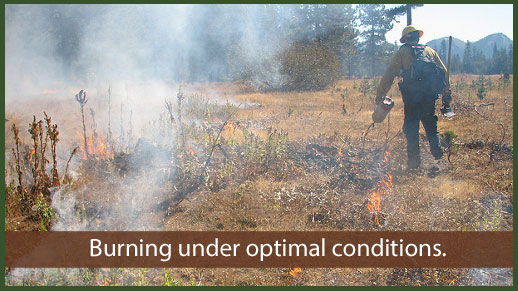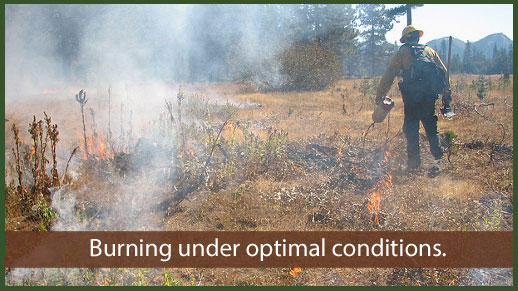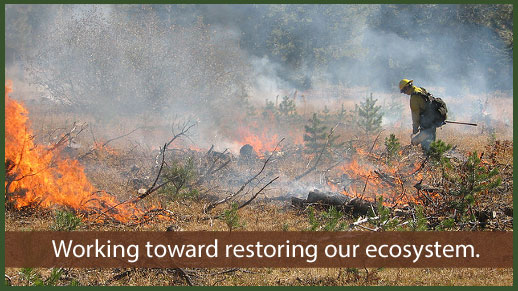Prescribed Fire
Did you know fire can be good for people and the land?
After many years of fire exclusion, an ecosystem that needs periodic fire – like ours – becomes unhealthy. Trees are stressed by overcrowding, fire-dependent species disappear, and flammable fuels build up and become hazardous. We use prescribed fire to help mitigate these issues. The term prescribed fire refers to the practice of igniting fires in specific areas under prescribed conditions to:

· Imitate the natural role of fire
· Reduce hazardous fuel buildups
· Propagate fire-dependent species
· Increase species diversity
· Maintain historic scenes and indigenous practices
For more than a century, the Forest Service has worked to prevent and suppress wildfires. In recent years, however, we have learned many ecosystems need occasional fire to thrive, including the Sierra Nevada. Restoring ecosystems includes thinning crowded forests and using prescribed fire, which can help prevent the buildup of flammable vegetation that feeds extreme fires. Here on the Sierra National Forest, we manage prescribed fires, and even some wildfires, to benefit natural resources and reduce the risk of unwanted wildfires in the future.
The right fire, at the right place, at the right time reduces hazardous fuels, protecting human communities (as well as our biological communities) from extreme fires. In other words, the practice of reducing the fuel in the Forest through prescribed burning results in creating conditions for less intense wildland fires. In addition, it can minimize the spread of pest insects and disease and remove unwanted species that threaten species native to an ecosystem. It can provide forage for game and also improve habitat for threatened and endangered species. Furthermore, it can create increased health among trees, as the competition for light, moisture, and nutrients is reduced.
Simply put, more prescribed fires mean fewer extreme wildfires and further progress towards restoring our ecosystems that benefit from fire.

Did you know that fire doesn’t “kill” everything?
Prescribed fire gives us a chance to burn an area at a lower intensity to protect the vegetation and soil. In a fire-adapted ecosystem like ours, many of the plant and tree species need fire to thrive. Using prescribed fire as a tool enables us to simulate this type of naturally occurring fire. For example, specific management strategies may be implemented to reduce the fuels and/or create a mosaic pattern in the vegetation to create cover, forage, and browse areas for wildlife. Prescribed fire can enhance native plant species and create diversity in vegetation structure and distribution. Some additional benefits of prescribed fire include:
· Reduced accumulation of dead and down material (such as needles, brush, and small and/or dead trees)
· Recycled forest nutrients
· Minimized insect epidemics and the spread of disease in crowded stands
· Firefighter safety; fires are smaller, less intense
· Reduced fuels in urban interface areas
Here’s how we do it:
Specialists write burn plans for prescribed fires. Burn plans identify – or prescribe – the best conditions under which trees and other plants will burn to get the best results safely. Burn plans consider temperature, humidity, wind, moisture of the vegetation, and conditions for the dispersal of smoke. Prescribed fire specialists compare conditions on the ground to those outlined in burn plans before deciding whether to burn on a given day – they also work hand-in-hand with the local air quality boards. We have fantastic people on the ground making critical decisions about how and when to burn, making sure we’re compliant with all land, resource, and air quality rules and regulations. Our folks are passionate about what they do and would love to talk with you about our upcoming prescribed burns today!
Smoke Management:
Prescribed fire is used only when temperature, humidity, wind speed, and fuel moisture are within the prescribed fire plan parameters. Prescribed fires can be ignited when weather and fuel conditions allow for minimized smoke impact on the public's air quality and public health. The Sierra National Forest works cooperatively with Local Air Pollution Control Districts to implement burn projects under conditions that will minimize smoke in sensitive areas.
For more information about how the Forest Service uses prescribed fire, click here
Click here for more information on Fuels Management on the Sierra National Forest.
Click here for more information on how the Sierra National Forest addresses Smoke Management.
Alerts & Warnings
- 05-15-00-24-12 SNF-Rec Site Road Trail Forest Order
- 05-15-52-24-13-SNF Basin Fire Closure
- 05-15-51-24-11 Nelder Grove Historic Area Closure Order
- 05-15-00-24-09-SNF Wilderness Campfire Restrictions Order
- 05-15-00-24-10 SNF Rec Site Road Trail Closure Order
- 05-15-00-24-07-SNF Wilderness Use Restrictions Order
- 05-15-00-24-05-SNF Food Refuse Storage Order
- 05-15-00-23-31-SNF Parking Limits
- 05-15-00-23-30-SNF Camping Limits
- 05-15-00-23-27-SNF-Wilderness Food Refuse Storage




